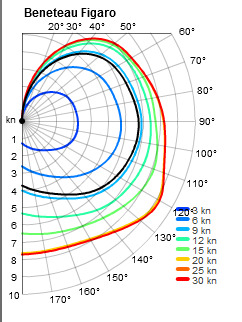
The Timetable.
By Dermot Tynan, almost 13 years ago.
The official start to hurricane season is June 1st, this year. The traditional end to the season is the end of November, but the hurricanes seem to wane out by early to mid-November. A back-of-the-envelope calculation says that it'll take up to sixty days to get from Start to Finish. That's a worst-case estimation, but useful nonetheless. If we are to launch before the start of the season, we'd need Beoga Beag sailing to the start line by April 1st at the latest. Let's face it, that's not going to happen. We don't have the pilot boat designed yet, we have extensive testing to do on the pilot boat, we need to then build the main boat, and start to fit her out. No way are we going to make that date.

To tack, or not to tack, that is the question...
By Dermot Tynan, almost 13 years ago.
Looking at the upper-level navigation software introduces some particularly interesting questions. The low-level software will keep the boat on a TWA, or true wind angle. Technically, it's an apparent wind angle, but that's ok.
The upper level has to decide what is the best TWA. To do this, it has the current position of the boat and the position of the next waypoint. It also knows the current TWA and the compass heading. Without bogging down in the maths, it can compute the distance and bearing to the next waypoint using something called a Haversin algorithm. Given the current TWA and the heading, it can determine the wind direction. We can compute the VMG or "velocity made good" for each new heading possibility, based on the predicted Polar (more on that anon). So, we can see that a particular heading is the best course to get us as fast as possible to the next mark. All of this is standard stuff, and is used on sailboat race courses every day.

Polar Curves
By Dermot Tynan, almost 13 years ago.
Even before a boat is built, the designers can predict how fast it will go at various sail angles. Using this information, they can make modifications to the hull to suit the type of sailing. For example, if an around-the-world race looks like it will see a lot of downwind sailing, it's possible to optimise the downwind performance, and run test simulations with the boat, before ever committing to fibreglass.
The standard mechanism for displaying this information is a polar curve. Because the boat should sail at the same speed on either tack, only one side is shown. Essentially, a polar curve allows the designer (and the boat owner) to predict the hull speed for a particular true wind angle and strength. In the example above (courtesy of SailOnline.org), you'll notice that the boats fastest speed is at a true wind angle of about 120 degrees. In the case of a 30 knot breeze (the red line), the boat should get over nine knots through the water. At TWA's of twenty degrees and less, the boat will stop, regardless of the wind speed.

Five Degrees of Wrong.
By Dermot Tynan, almost 13 years ago.
So, as I mentioned, the virtual boat was too eager to tack. If you're dead downwind of the mark, and you set off on a starboard tack, within a metre of being on the left-hand side of the course, the other tack is favoured.
I added code that essentially stated "unless the other tack is at least five degrees better than the existing one, ignore it." So, if I'm at 44 degrees TWA and the other tack is better by a degree (-43 say), stay where you are. This works quite nicely. If you look at the plotted course, it shows the boat sailing nice upwind legs, to the waypoint. As Henry would say, "it's sailing up the ladder."

The Software...
By Dermot Tynan, almost 13 years ago.
I've been asked recently, about the software platforms used on board Beoga Beag. This seems as good a time as any, to talk about the various layers. As mentioned previously, the lower layer is a custom board, running an ATmega8 Atmel processor. The software (Igor and Otto) is custom-written in C for the boat.
Upcoming Missions
- Galway Bay Loop, Waiting for Vessel Availability
Search
Recent Posts
- May 2023 (1 post)
- April 2023 (1 post)
- March 2023 (1 post)
- February 2023 (2 posts)
- March 2022 (3 posts)
- March 2021 (1 post)
- August 2020 (1 post)
- May 2019 (1 post)
- April 2018 (1 post)
- November 2017 (1 post)
- April 2017 (1 post)
- November 2016 (1 post)
- September 2016 (1 post)
- August 2016 (1 post)
- January 2014 (2 posts)
- October 2013 (7 posts)
- September 2013 (1 post)
- August 2013 (3 posts)
- June 2013 (3 posts)
- May 2013 (4 posts)
- April 2013 (3 posts)
- March 2013 (9 posts)
- February 2013 (8 posts)